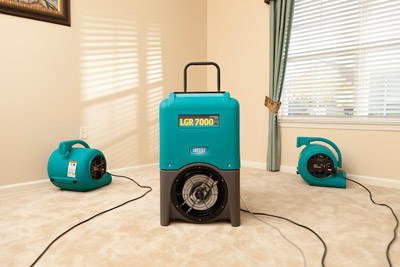 When determining the amount of dehumidification that is necessary, mitigation firms may employ guidelines outlined within the Applied Structural Drying (ASD) training course. ASD is an IICRC (Institute of Inspection, Cleaning and Restoration Certification) certified training course.
When determining the amount of dehumidification that is necessary, mitigation firms may employ guidelines outlined within the Applied Structural Drying (ASD) training course. ASD is an IICRC (Institute of Inspection, Cleaning and Restoration Certification) certified training course.
Types of Dehumidifiers:
The most commonly used dehumidification tool employed while mitigating a water loss is the refrigerant dehumidifier. The industrial grade dehumidifier is designed to operate in cooler conditions than most homeowner units. It will operate at temperatures down to 45 degrees Fahrenheit, but should not be operated above 100 degrees Fahrenheit. For best operation, maintain temperatures between 70 and 80 degrees Fahrenheit. There are two types of refrigerant dehumidifiers:
- Commercial (or “standard”) refrigerant Dehumidifiers: most common in the restoration industry. Most effective in warm and humid conditions.
- Low Grain Refrigerant (LGR) Dehumidifiers: LGR dehumidifiers employ new technologies that enable them to remove higher levels of water at lower humidity and can ultimately dry to a lower moisture level than “standard” refrigerants. They are also able to accomplish this using less electricity.
- Desiccant Dehumidifier: Desiccant dehumidifiers employ a silica gel absorbent to remove moisture from the air. They have the ability to dry the air to a lower level than standard refrigerant or LGR dehumidifiers and can be an effective tool when drying hardwood floors, built-ins and cabinets, dense structural materials, plaster, brick, books, and documents. They are also useful when temperatures are below 50 degrees Fahrenheit.
To determine dehumidification requirements, the class of water damage must first be evaluated. The extent of water damage and the affected materials determine the class of loss.
Classes of Water Damage:
- Class 1: Slow Rate of Evaporation – Water losses that affect only part of a room or area; or losses with little or no wet carpet and/or cushion. Damage is confined to a small area, or has been wet for a short period. When materials with low-permeance/porosity are involved, (e.g. plywood, particle board, structural wood, VCT, concrete), minimum moisture has been absorbed.
- Class 2: Fast Rate of Evaporation – Water losses that affect the entire room of carpet and cushion. Water has wicked up walls less than 24 inches. There is moisture remaining in structural materials (e.g. plywood, particle board, structural wood, VCT, concrete).
- Class 3: Fastest Rate of Evaporation – Water may have come from overhead. Ceilings, walls, insulation, carpet, cushion, and sub floors in virtually the entire area are saturated.
- Class 4: Specialty Drying Situations – These losses involve wet materials with very low permeance/porosity (e.g. hardwoods, sub floor, plaster, brick, concrete, stone, and crawlspaces). Typically, there are deep pockets of saturation that normally require very low specific humidity.
